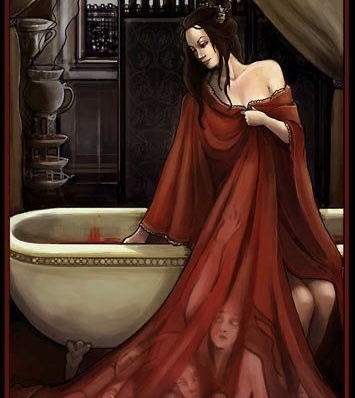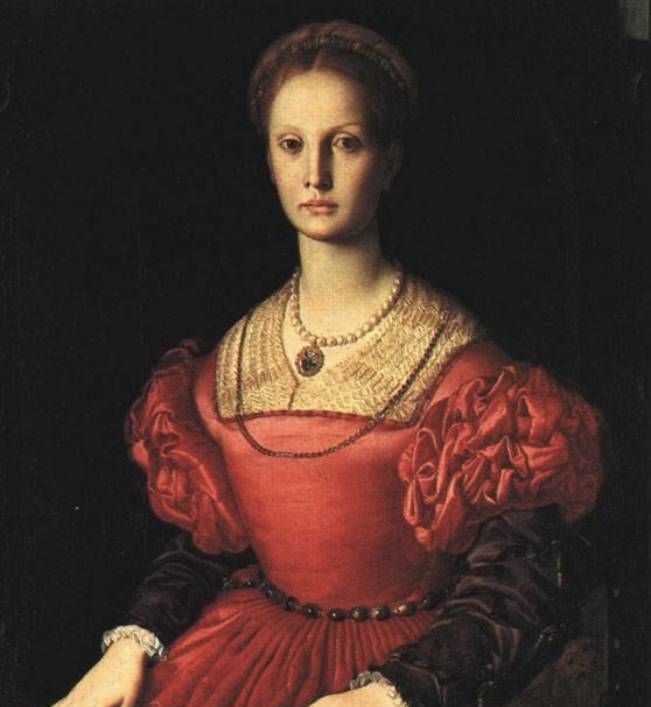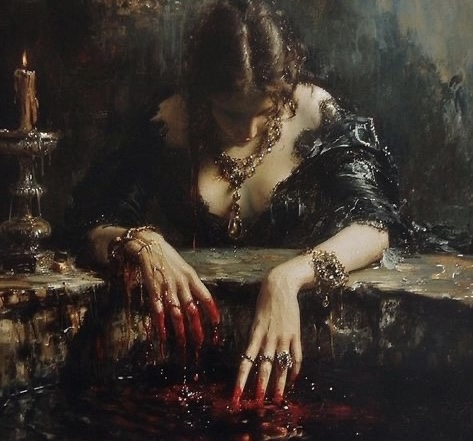When you think of scary stories, you might picture Dracula [hiding in a creepy castle or a masked villain from a horror Hollywood movie. But one of the most terrifying tales does not come from fiction.
It is based on the real-life story of a powerful Hungarian noblewoman. Her name is Elizabeth Báthory; she is also known as the Blood Countess.
The Blood Countess is said to have killed hundreds of young women in the late 1500s and early 1600s. Some even claim that she bathed in her victim’s blood to preserve her beauty, which makes her one of the most famous names in Gothic legends.
When she turned fifteen, Elizabeth married Ferenc Nádasdy, another wealthy nobleman, who was nicknamed the “Black Hero” for his military skills.
However, here is the twist: historians are still debating whether she was truly a sadistic serial killer or if her story was twisted by enemies who were hungry for power and land.
So, buckle up. We are heading back to early modern Europe, where castles still dominated villages, superstition ran rampant, and power struggles could be as bloody as any horror movie.
The World of Elizabeth Báthory
Elizabeth Báthory was born in 1560 into one of the most powerful families in Hungary. The Báthory clan was renowned in Central and Eastern Europe, where they were recognized for producing distinguished soldiers, politicians, and rulers.
Her family tree was filled with royals, nobles, and even kings. She wasn’t just born wealthy; she was nearly untouchable.
From an early age, Elizabeth was surrounded by privilege. She had an education, which was a rare thing for women at that time. She had wealth and servants at her disposal. What more could she want, right?

Well, Elizabeth grew up in a world filled with violence and superstition. Torture, public executions, and witchcraft accusations were not shocking back then; they were just parts of life.
When she turned fifteen, Elizabeth married Ferenc Nádasdy, another wealthy nobleman, who was known as the “Black Hero” for his exceptional military skills. Their wedding was massive, and as a gift, Ferenc gave Elizabeth Cachtice Castle, a brooding fortress that would later become the stage for her alleged crimes.
Whispers of Cruelty
At first, Elizabeth lived the life that you would expect of a noblewoman. She managed the estate while her husband was off fighting the Ottoman Turks, a job that involved overseeing peasants, servants, and numerous household tasks.
However, as the years passed, whispers began to spread. Servants talked about her violent temper. Some stories claim that she would slap or beat her maids for the smallest mistakes.

It is important to remember that any form of cruelty towards servants was not unusual in 16th-century Europe. Nobles often punished their staff harshly, and peasants had little power to complain.
But with Elizabeth, the rumors were darker. There were tales of beatings that went too far, punishments that seemed sadistic, and missing servant girls who were never seen again.
When Ferenc died in 1604, Elizabeth became a widow at forty-four, and it was then that the accusations escalated into something out of a Gothic nightmare.
The Legend of the Blood Countess
According to legend, Elizabeth Báthory did not just discipline her servants; she murdered them in terrifying ways. Witnesses later claimed that she would lure young peasant girls to her castle with promises of work, only for them to vanish behind its stone walls.
The most sensational stories, of course, insist that she drained their blood and bathed in it.
Some said she would torture them with needles, knives, or branding irons. Others claimed she locked them in freezing water until they died, and there were also some who said she starved her victims to death in dungeons.
The most sensational stories, of course, insist that she drained their blood and bathed in it, and she did it because she believed it would keep her skin young and beautiful.

It is hard not to shiver at the image of a noblewoman standing in a stone bathtub filled with crimson water, convinced that she had found the secret to eternal youth. It sounds straight out of a horror novel, which is exactly why this part of the story has stuck around for centuries.
But this is where things get tricky: did Elizabeth really do all of this, or was it exaggerated?
The Investigation
By 1609, the rumors had grown impossible to ignore. Too many peasant families had complained that their daughters had gone to work for the Countess and never returned. Even worse, some noble families claimed that their daughters had been sent to Elizabeth’s court for education and refinement, only to disappear mysteriously.
Finally, King Matthias lI of Hungary ordered an investigation. He sent György Thurzó, the Palatine of Hungary (essentially the King’s top official), to investigate the matter. When Thurzó arrived at Cachtice Castle in 1610, the stories claim that he walked straight into a horror show.
Some of them claimed that the Countess has killed as many as 600 girls; a number so staggering it would make her the most prolific serial killer in history.
Some accounts say that he found girls bleeding and dying on the floors, while others describe tortured bodies stuffed into shallow graves around the castle grounds. After the discovery, Elizabeth was arrested, along with several of her servants who were accused of helping her.
The Trial That Shocked Europe
The trial of Countess Báthory was one of the most sensational events in early modern Europe. Dozens of witnesses came forward to give gruesome testimonies of what they had seen or heard. Some of them claimed that the Countess had killed as many as 600 girls; a number so staggering it would make her the most prolific serial killer in history.

Her servants, under torture, confessed to helping her. They described in detail the cruel punishments and murders that had supposedly taken place inside the castle.
However, here’s the thing. Elizabeth herself was never put on trial. As a noblewoman from such a powerful family, putting her in court might have caused political chaos. So, instead of her, her servants were executed, and Elizabeth was quietly sentenced to life imprisonment in her castle.
Elizabeth spent her final years confined to a set of rooms within Cachtice Castle. Some say she was confined to a chamber with only a small hole for food to be passed through, while others claim she lived more comfortably, albeit under strict guard.
She died in 1614 at the age of 54. By then, she was already a legend, and her name was whispered in fear across Europe.
Gothic Legend vs. Political Reality
Now, this is where we have to step back and ask: was Elizabeth Báthory really history’s most notorious serial killer, or was she a victim of political intrigue?
Was she really a bloodthirsty murderer, or was she framed because greedy politicians wanted her fortune?
Historians today are divided. On one hand, the testimonies from her trial describe a truly horrifying picture, while on the other hand, many of those testimonies were gathered under torture; the supposed witnesses might have said anything to save themselves.
There is also the fact that Elizabeth was extremely wealthy and powerful, and her lands were very valuable. By accusing her of crimes, the crown could seize her estates. This, therefore, leads to an important question: Was she really a bloodthirsty murderer, or was she framed because greedy politicians wanted her fortune?
Regarding the legend of bathing in blood, many historians believe this detail was invented later. They believe it was fueled by gothic storytellers who wanted to paint her as a female vampire.
In the 18th and 19th centuries, when vampire tales like Dracula were exploding in popularity, Elizabeth’s story fits perfectly into the genre. The image of the Blood Countess soaking in a bathtub of blood was probably too sensational for writers to resist.

So, Was She Guilty?
The mystery of Elizabeth Báthory remains unsolved. Was she a cruel noblewoman who got carried away with her temper, accidentally killed a few servants, and then had her crimes exaggerated into wild stories?
Was she truly a sadistic serial killer who murdered hundreds of young women? Or was she simply a pawn in a larger political game, whose name was smeared in the hopes of stripping her family of power?
Maybe she was a murderer. Maybe she was framed. Or maybe, like so many figures from history, the truth is somewhere in between.
We may never know the full truth, but we know one thing. Her legend has lived on for more than 400 years. The idea of the Blood Countess bathing in blood continues to haunt many people’s imagination, a gory reminder of how history and myth can blend together into something unforgettable.
Conclusion: The Countess Who Became a Legend
Elizabeth Báthory’s story is both terrifying and fascinating. On the surface, she is remembered as the world’s most notorious female serial killer, a woman who turned her castle into a house of horrors. But when you dig deeper, you will find layers of political, myth-making, and gothic exaggeration.
Maybe she was a murderer. Maybe she was framed. Or maybe, like so many figures from history, the truth is somewhere in between. What is undeniable is that her legend has stood the test of time. When we think of haunted castles, blood-soaked rituals, and gothic nightmares, the image of the Blood Countess is never far away.
What do you believe? Do you think Elizabeth was a real monster or was she painted as one? Drop your thoughts in the comments below and share with a friend.
Sources and Further Reading:
- Elizabeth Báthory overview → EBSCO Research Starters (Elizabeth Báthory: Hungarian noblewoman accused of mass murder).
- Biography summary → Biography.com (Elizabeth Báthory: “The Blood Countess” and alleged serial killer)
- Trial exposure (1610 raid, crimes reviewed) → History.com (This Day in History: “Báthory’s torturous escapades are exposed”)
- Key facts and myths → History Hit (The Blood Countess: Facts about Elizabeth Báthory)
- Modern media reference → BBC News (Cambridgeshire woman cast as Elizabeth Báthory in stage play, 2023)

